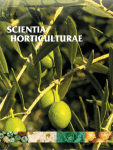Ver ítem
- xmlui.general.dspace_homeCentros Regionales y EEAsCentro Regional Catamarca - La RiojaEEA ChilecitoArtículos científicosxmlui.ArtifactBrowser.ItemViewer.trail
- Inicio
- Centros Regionales y EEAs
- Centro Regional Catamarca - La Rioja
- EEA Chilecito
- Artículos científicos
- Ver ítem
Fruit, mesocarp, and endocarp responses to crop load and to different estimates of source: sink ratio in olive (cv. Arauco) at final harvest
Resumen
The annual fluctuations in olive crop load due to alternate bearing and other factors often lead to large differences in fruit size and oil content between years at harvest. A better understanding of how fruit parameters respond to the different leaf: fruit (i.e., source: sink) ratios that occur with contrasting crop loads would provide important information for crop management. Thus, the primary objectives of this study conducted with the cv. Arauco in
[ver mas...]
The annual fluctuations in olive crop load due to alternate bearing and other factors often lead to large differences in fruit size and oil content between years at harvest. A better understanding of how fruit parameters respond to the different leaf: fruit (i.e., source: sink) ratios that occur with contrasting crop loads would provide important information for crop management. Thus, the primary objectives of this study conducted with the cv. Arauco in three growing seasons were to: 1) determine the weight and size responses of the fruit and its main tissues, mesocarp (pulp) and endocarp (pit), to crop load; and 2) obtain relationships between different estimates of the source: sink ratio versus various fruit and oil parameters. Fruit thinning was performed by hand on uniform trees with high initial crop loads four weeks after full bloom the first season to obtain different crop loads at harvest. The thinning percentages the first season were 24%, 48% and 87%, along with an unthinned control. The same trees were then monitored the following two seasons without any further thinning. Fruit were sampled at harvest each season to determine fruit and tissue weights and diameters, oil weight per fruit, and oil concentration (%). Fruit weight was reduced 30–40% by high crop loads in each growing season with the mesocarp being much more affected than the endocarp. Oil weight per fruit (−50%) showed a somewhat greater reduction than fruit weight to crop load due to both fruit diameters and fruit oil concentration being decreased at high crop loads. Fruit and tissue weights and oil weight per fruit all displayed bilinear functions versus source: sink ratio when the source was expressed as canopy volume (a surrogate for leaf area) and sink on both a fruit number and glucose equivalent (GE) basis. Source limited fruit growth at both medium and high crop loads due to limited photoassimilate availability based on the bilinear functions, and the slope of the endocarp response to source: sink ratio was 15 times less than that of the mesocarp when expressed on a GE basis. A quantitative comparison with previously published studies indicated that maximum fruit weight appears to be obtained in olive between 1–2 m2 of leaf area per kg of GE. The bilinear relationships of source: sink ratio versus fruit weight observed in this study could contribute to crop modelling, and further research concerning how and when the mesocarp and endocarp respond to crop load is needed to aid crop management in obtaining sufficient fruit size and quality for table olive cultivars.
[Cerrar]

Autor
Fernandez, Fabricio;
Ladux, Jose Luis;
Hammami, Sofiene B.M.;
Rapoport, Hava F.;
Searles, Peter Stoughton;
Fuente
Scientia Horticulturae 234 : 49-57 (April 2018)
Fecha
2018-04-14
ISSN
0304-4238
Formato
pdf
Tipo de documento
artículo
Palabras Claves
Derechos de acceso
Restringido
 Excepto donde se diga explicitamente, este item se publica bajo la siguiente descripción: Creative Commons Attribution-NonCommercial-ShareAlike 2.5 Unported (CC BY-NC-SA 2.5)
Excepto donde se diga explicitamente, este item se publica bajo la siguiente descripción: Creative Commons Attribution-NonCommercial-ShareAlike 2.5 Unported (CC BY-NC-SA 2.5)

